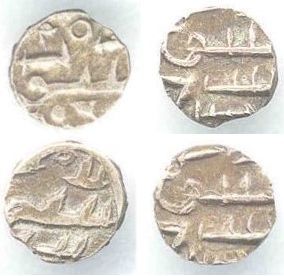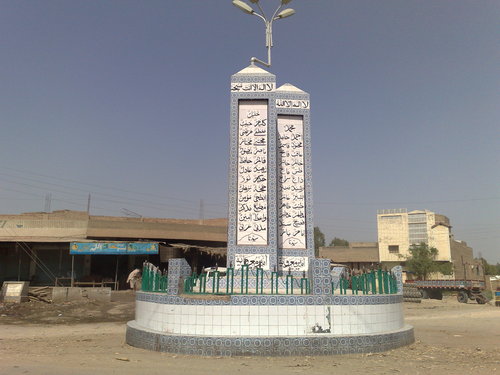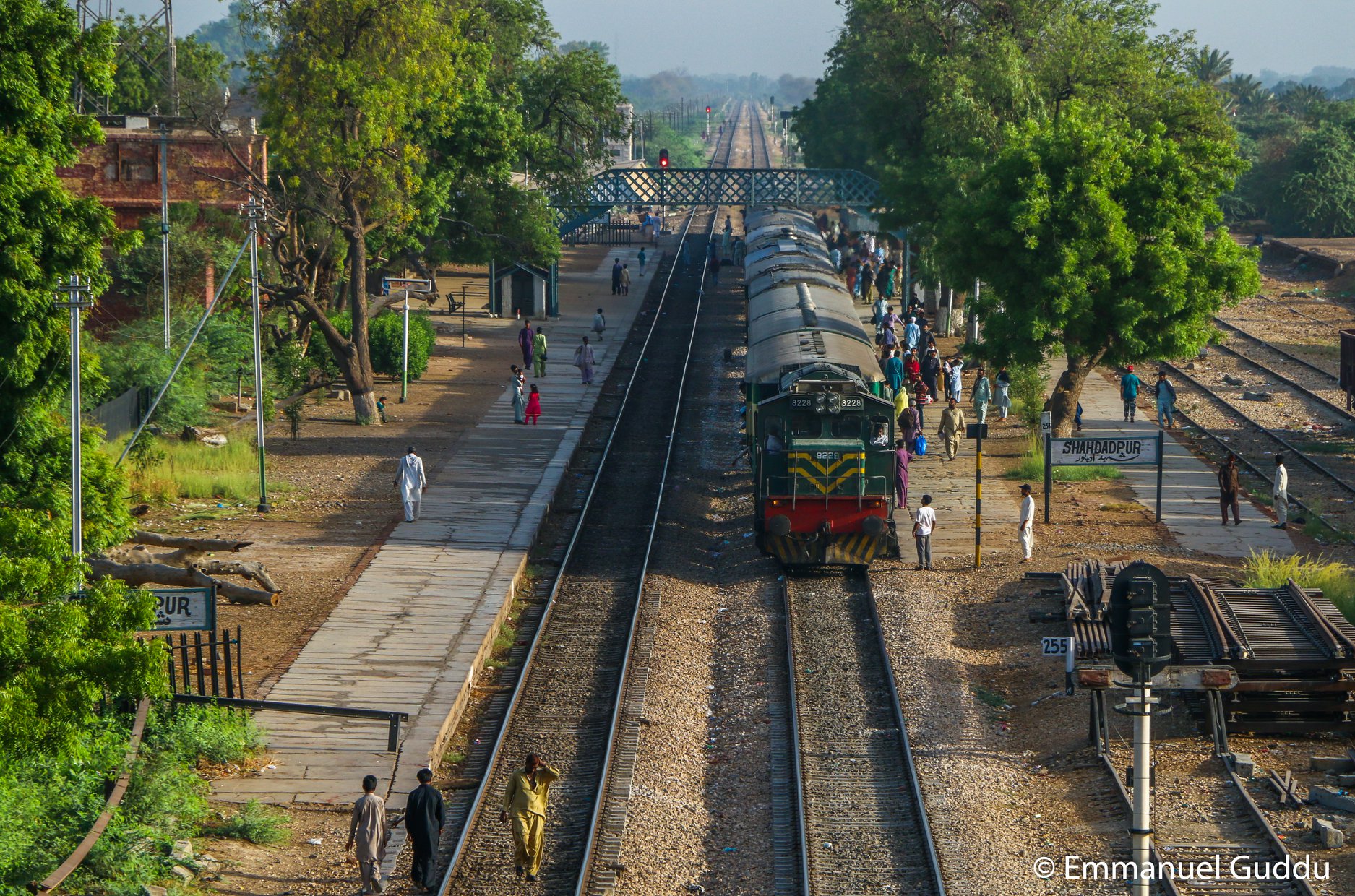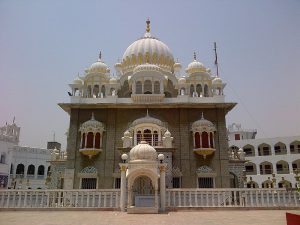Shahdadpur is a city in Sindh, a province of Pakistan. It is located at 27°51’N and 67°64’E. The historical city of al-Mansura is situated about 19 km south-east of Shahdadpur. The shrines of Sohni and Mehinwal, from the Sohni Mahiwal story, are located in and near to the city, the shrine of Sohni is near to the city whilst that of Mehinwal is in the centre of the city. Shahdadpur has four union councils. It is one the major cities of district Sanghar. Shah Abdul Latif Bhittai (whose shrine is about 10 km from Shahdadpur in Bhit Shah) immortalised their love through his poetry particularly in the context of passion and affection
In a recent study Dr.N.A.Baluch,an eminent historian, scholar and former Vice-Chancellor of Sindh University has proved that Mir Shahdad Khan founded Shahdadpur during the years 1125A.H.-1128A.H (1713-1715). In an 1116A.H (1704) document Mir Shahdad Khan is referred to as “Riffat Panah” meaning His Eminence. The document shows that Mir Shahdad Khan not only had barren lands cultivated but also provided security to the populace by ridding the region of dacoits (thieves). He established new norms for the sharing of produce between the owners and tillers. Mir Shahdad Khan had old canals and waterways renovated and also extended them. He had new canals dug as well and that was how he established the new settlement of Shahdadpur.
City and People
People living in Shahdadpur belong to different races and communities such as Talpur, Abbasi, Soomra,Chandio,Dal, Sand, Lakha, Abra, Khosa, Surhia, Sarhandi Pir, Sindhi Pathan, memon, Dahri, Jamali, Brohi, Magsi, Lashari.Rajput, Quershi, and many sindhi communities. Majority of the people living in the city are Sindhi 70% speaking and Urdu Speaking are 25% and other 5% and diffetrent languages while the huge number of sindhi speaking live in the villages near to the city. The huge number of Punjabi speakers also lives in the city and neary by villages.
Mansura (Arabic: منصورہ) was the historic capital of the Arab empire in Sindh. The city now lies in Western Pakistan and is usually known as Brahmanabad in Sindh, situated about 8 miles (13 km) south-east of Shahdadpur railway station, and 43 miles (69 km) north-east of Hyderabad.
In the Chachnama we find frequent mention of a chief Agham Lohana who was ruler of Brahmanabad with their two terretorie lakha to the west of Lohana and Sama to the south of Lohana (Nerron) Narayankot Hyderabad, Sindh in the time of Chach 636AD
The city was the first in the Muslim world constructed by using the principles of town planning later used throughout Muslim territory including in the construction of Baghdad 17 years after the city’s foundation. Built by Khalid ibn Barmak, a Muslim governor of the  Umayyad Caliphate who was a Persianized descendent of Kashmiri Brahmans or Buddhist priests who had moved to Balkh in present day Afghanistan. Mansura was originally called Brahmanabad after its Brahman builder who would later play a decisive role in buildingBaghdad in modern day Iraq where he protested against the use of material from ancient Mesopotamian Ctesiphon to build the new city[citation needed]. The Barmakids wielded great influence with the Arabs. Under the Caliphate of Al-Mansur, Khalid was appointed governor of Fars and, after helping obtain Prince ‘Isa ibn Musa‘s renunciation of his succession to the caliphate in 765, became governor of Tabaristan. Around the same time, his son Yahya ibn Khalid, was appointed governor of Azerbaijan.
Umayyad Caliphate who was a Persianized descendent of Kashmiri Brahmans or Buddhist priests who had moved to Balkh in present day Afghanistan. Mansura was originally called Brahmanabad after its Brahman builder who would later play a decisive role in buildingBaghdad in modern day Iraq where he protested against the use of material from ancient Mesopotamian Ctesiphon to build the new city[citation needed]. The Barmakids wielded great influence with the Arabs. Under the Caliphate of Al-Mansur, Khalid was appointed governor of Fars and, after helping obtain Prince ‘Isa ibn Musa‘s renunciation of his succession to the caliphate in 765, became governor of Tabaristan. Around the same time, his son Yahya ibn Khalid, was appointed governor of Azerbaijan.
Mansura’s history began under the Umayyad Caliphs when Muslim Arabs attempted to conquer the frontier kingdoms of India, Kabul,Zabul, and Sindh, but were repulsed. In the early 8th Century, with the Kingdom of Sindh convulsed by internal strife, the Arabs seized their chance and renewed the assault. Thereafter it was captured by Muhammad bin Qasim, nephew of Al-Hajjaj ibn Yusuf (661–714), the governor of Iraq and Khurasan. Qasim’s successors attempted to expand from Sindh into the Punjab and other regions but suffered heavy defeats at the hands of Lalitaditya Muktapida in Kashmir and Yasovarman in Kannauj[citation needed].
Mansura was founded by Umar[citation needed], son of Muhammad Bin Qasim in the third or fourth decade of the 8th century and the city is not named after Abbasid Caliph Al-Mansur[citation needed]. Al-Masudi was also wrong when he ascribed the foundation of the  city to Governor Mansur bin Jamhur[citation needed], the last Umayyad Governor of Sindh[citation needed]. The city holds an important position inMuslim history as the first to be built by Arabs according to the principles of town-planning[citation needed]. Seventeen years later, lessons learned in Mansura were applied in Baghdad where there were once numerous Sindhi inspired buildings and monuments[citation needed].
city to Governor Mansur bin Jamhur[citation needed], the last Umayyad Governor of Sindh[citation needed]. The city holds an important position inMuslim history as the first to be built by Arabs according to the principles of town-planning[citation needed]. Seventeen years later, lessons learned in Mansura were applied in Baghdad where there were once numerous Sindhi inspired buildings and monuments[citation needed].
According to historians[clarification needed Who?], Brahmanabad was a beautiful town with vast orchards of mangoes and groves of date palms. Today the ruins of Brahmanabad are spread over an area 4 miles (6.4 km) in circumference near the modern city of Shahdadpur. The most significant ruin found in Mansura is the large courtyard of a Jamia Masjid (mosque), while the remains of temples destroyed by the Muslims were re-used to build mosques[citation needed], leaving no remains other than a small temple structure called a deri (or deval) in Indian languages, which may have been related to the practice of salt.
Modern ruins
The city lies upon the open sandy plain amongst rolling heaps of brick debris, criss-crossed with the depressions of its original streets and surrounded by the ruins of its once massive walls and bastions. Shaped like a boot with the sole facing north-west and the leg stretching south-east, the whole area has a circumference of 5.75 miles (9.25 km). Apart from a considerable area towards the south-east end, the whole space is covered with billowing mounds of brick ruins. Nothing now stands above  the surface, except in one place, where an unrecognizable tower-like core of brick masonry remains. There is a total absence of stone masonry of any kind, but lumps of charred wood dotted here and there indicate the former presence of woodwork. The cement used in the brickwork appears to have been mud which forms the greater mass of the present mounds.
the surface, except in one place, where an unrecognizable tower-like core of brick masonry remains. There is a total absence of stone masonry of any kind, but lumps of charred wood dotted here and there indicate the former presence of woodwork. The cement used in the brickwork appears to have been mud which forms the greater mass of the present mounds.
Mir Shahdad Jo Qubo (“the tomb of Mir Shahdad Talpur”) is the tomb of Mir Shahdad Talpur, who is regarded as one of the finest military commanders of Sindh. It is a monument of historical importance, situated in Shahpur Chakar of Sanghar District, Pakistan.
Though this is very old graveyard of Talpur family but main personalities Mir Shahdad Khan Talpur and Mir Chakar Khan Talpur are well known generals in 12th century and it was Kalhora period in Sindh at that time. This is a graveyard of the family members of Mir Shahdad Talpur. Shahdadpur a big city of Province Sindh is named behind Mir Shahdad Talpur, and Mir Chakar Khan Tallpur. Shahpur Chakar is named behind his son Mir Chakar Talpur.
